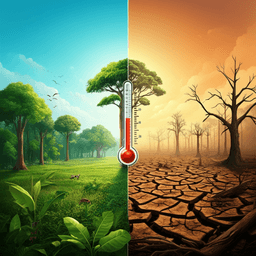
Earth Sciences
Deforestation and climate change are projected to increase heat stress risk in the Brazilian Amazon
B. F. A. D. Oliveira, M. J. Bottino, et al.
Explore how the Amazon Basin's savannization impacts heat stress indices under climate change scenarios brought to light by researchers Beatriz Fátima Alves de Oliveira, Marcus J. Bottino, Paulo Nobre, and Carlos A. Nobre. Discover alarming predictions that over 11 million people might face extreme heat risks by 2100 due to these combined effects.
~3 min • Beginner • English
Introduction
The study addresses how Amazon rainforest deforestation (savannization) and global climate change jointly affect human heat stress risk in Brazil, focusing on the wet-bulb globe temperature (WBGT) index. Rising global temperatures, recent extreme heat events in Brazil, and accelerating Amazon deforestation underscore concerns about intensified regional warming and humidity changes that can compromise human thermoregulation. Prior work indicates Amazon deforestation can substantially reduce rainfall and increase near-surface air temperatures, potentially aggravating heat exposure. The authors aim to quantify how land-use change and greenhouse gas forcing scenarios (RCP4.5 and RCP8.5) alter WBGT, and to assess implications for human health, workability, and vulnerability across Brazilian regions.
Literature Review
The paper situates its work within research showing increasing frequency and intensity of heat stress conditions in tropical and subtropical regions, with recent records in South America. Studies have projected large air temperature changes for Midwestern and Northern Brazil under climate change. Foundational work suggested Amazon deforestation could reduce rainfall by ~60% and increase near-surface temperature by ~2 °C, implying significant regional climatic impacts. Heat stress science links morbidity and mortality to impaired thermoregulation under high temperature/humidity and identifies key environmental determinants (temperature, humidity, solar radiation, wind). Among various indices, WBGT is widely used in occupational, military, and sports contexts with established thresholds guiding work-rest cycles, including recommendations for rest when WBGT exceeds 26 °C, cessation at 34 °C, and survivability concerns above 40 °C. Prior literature also documents impacts on productivity and health outcomes (cardiovascular, mental health), suggesting profound societal implications of rising heat stress.
Methodology
The authors used the Brazilian Earth System Model (BESM-OA2.5), a coupled ocean–atmosphere model comprising the Brazilian Global Atmospheric Model (BAM; T62 horizontal resolution ~1.875° x 1.875° at the Equator, 28 sigma vertical levels) and GFDL MOM4p1 ocean model. Surface fluxes and soil conditions were simulated with the SSib surface model parameterized by 13 surface cover types. Two land-cover maps were used: (1) Forested—original map with Amazon as broad-leaf evergreen trees (tropical rainforest); and (2) Deforested—Amazon replaced by broad-leaf trees with ground cover (savanna), representing savannization. Following CMIP5 protocol, six 30-year experiments were run: Historical (1981–2010) and two future scenarios (2071–2100) under RCP4.5 and RCP8.5, each with Forested and Deforested conditions, producing hourly outputs. WBGT estimation: Outdoor WBGT was calculated using the Liljegren et al. method, incorporating temperature, humidity, solar radiation, and wind speed: WBGT_outdoor = 0.7 T_nwb + 0.2 T_g + 0.1 T_a. In-shade (indoor) WBGT used Bernard’s method (temperature and humidity with constant wind, no solar): WBGT_indoor = 0.7 T_pwb + 0.3 T_a. Risk thresholds were defined as: moderate (26–<30 °C), high (30–<34 °C), extreme (≥34 °C), and survivability risk (≥40 °C). Meteorological data and bias correction: ERA5 reanalysis (hourly temperature, humidity, solar radiation, wind) was interpolated to BESM resolution. Historical (1981–2010) ERA5-based WBGT provided reference for bias correction via a standard-normal deviate scaling matching monthly/hourly means (M) and standard deviations (S) between model and observations: T' = (T − M_m) S_o/S_m + M_o. Bias parameters from the forested Historical simulation and ERA5 were applied to all experiments. Population and vulnerability analysis: From hourly WBGT, daily maxima were extracted, and monthly climatologies computed; the warmest month’s WBGT field was interpolated to the centroids of 5,565 Brazilian municipalities and linked to 2019 population counts. Social Vulnerability Index (SVI) data (human capital, urban infrastructure, income/work; 0–1 scale) categorized municipalities into low/moderate (<0.400), high (0.401–0.500), and very high (0.501–1.000) vulnerability. Impacted municipalities were those with increases >0.2 °C in average daily maximum in-shade WBGT in the hottest month (85S − 85F).
Key Findings
- Amazon savannization strongly increases heat stress. In the warmest month, average daily maximum in-shade WBGT exceeded the extreme risk threshold (≥34 °C), reaching maxima of 37 °C (RCP4.5 savanna; 45S) and 41 °C (RCP8.5 savanna; 85S). Outdoor maximum daily average WBGT reached 46 °C in 85S.
- Deforestation under present-day greenhouse gases (HS vs HF) increased average daily highest in-shade WBGT by 1–5 °C over the Amazon. Under future climate forcing, deforestation added up to 7.5 °C (85S − 85F), with broader regional increases of ~0.5 °C in parts of the Andes and South/Southeast Brazil in RCP8.5.
- Combined effects of deforestation and climate change (85S − HF) increased in-shade WBGT by up to 11.5 °C by late century relative to historical conditions, with 2–5.5 °C increases across most of South America outside the Amazon even without deforestation.
- Frequency shifts: In-shade daily maximum WBGT distribution under historical savannization approximated the end-century RCP8.5 forested case, indicating deforestation effects comparable to severe climate change. Under 85S, in-shade WBGT >34 °C occurred on 42% of days; outdoor WBGT >40 °C occurred on 7% of days (~25 days/year), with some days exceeding 46 °C.
- Population exposure: Additional people exposed to in-shade extreme risk (WBGT ≥34 °C) due to deforestation were >6 million (RCP4.5) and >11 million (RCP8.5), relative to no-savannization. Under RCP8.5, about 50% (~5.7 million) of those exposed live under high social vulnerability. For outdoor survivability threshold (WBGT >40 °C), ~5 million people could be affected by century’s end, including ~2 million highly vulnerable individuals.
- Municipal impacts: 16% (887) of Brazilian municipalities, comprising 29,648,362 people, would be impacted (increase >0.2 °C in in-shade WBGT) under RCP8.5 savannization; 42% of the impacted population resides in the Northern region, with many municipalities exhibiting high/very high vulnerability (SVI ≥0.400), and low resilience.
- Workability implications: Under 85S, heavy outdoor activities would be impossible for at least 1 hour/day on 42% of days (WBGT >34 °C).
Discussion
The findings demonstrate that large-scale Amazon savannization amplifies regional heat stress to levels comparable to or exceeding those produced by severe climate change alone, directly addressing the research question of how land-use change and greenhouse forcing jointly affect WBGT. The modeled increases in both magnitude and frequency of extreme WBGT, including exceedances of human adaptation limits, imply substantial risks to health (e.g., heat-related morbidity and mortality, cardiovascular and renal outcomes, mental health) and to labor productivity and safety, particularly for outdoor and heavy work. The most affected populations are concentrated in Northern Brazil, where high social vulnerability and limited infrastructure reduce adaptive capacity, compounding risks. Observational evidence of stronger warming over deforested areas supports the modeled mechanisms. The convergence of climate and land-use drivers, combined with socioeconomic vulnerabilities, signals escalating demands on health and social protection systems, as already evidenced by regional stresses (e.g., pandemic-related health system strain).
Conclusion
This study shows that deforestation-driven savannization of the Amazon, combined with climate change, will markedly elevate WBGT-based heat stress across Brazil, with especially severe impacts in the Amazon Basin and among socially vulnerable communities. Projected conditions include frequent exceedance of thresholds for safe work and potential survivability risks outdoors by late century under high emissions. These results underscore urgent needs for policies that prevent further deforestation, strengthen forest sustainability, and implement integrative health and occupational protections to mitigate risk and vulnerability. Coordinated actions across sectors, including the health sector, are essential to safeguard human well-being in the face of compounding climate and land-use pressures.
Limitations
- Model uncertainty: As with all climate models, BESM-OA2.5 projections carry uncertainties.
- Scenario representation: The savannization scenario assumes a worst-case, large-scale replacement of rainforest with savanna, which may overstate localized effects if deforestation is less extensive or heterogeneous.
- Bias correction scope: The statistical correction matched only means and standard deviations (first and second moments) and used parameters from the forested Historical period for all experiments.
- Static vegetation and coarse resolution: SSib uses seasonally parameterized, static surface properties at ~1.875° resolution, potentially limiting fine-scale land–atmosphere feedback representation.
- Population assumptions: Exposure analyses did not account for future population growth, demographic changes, or life expectancy, reflecting impacts on the current population distribution only.
- Forcing constraints: Historical runs used greenhouse gas forcing only; other aerosols/land-use forcings were not explicitly detailed.
Related Publications
Explore these studies to deepen your understanding of the subject.







